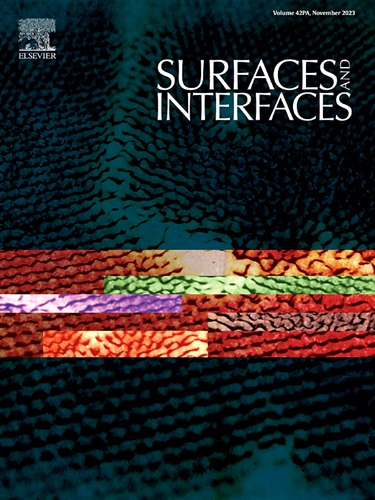一种新型Fe₂O₃负载g-C₃N₄电极的构建,用于高能和可持续的不对称混合超级电容器
IF 6.3
2区 材料科学
Q2 CHEMISTRY, PHYSICAL
引用次数: 0
摘要
日益增长的全球能源消耗和环境可持续性要求迫切需要电化学存储技术的创新。超级电容器具有快速充电和超长寿命的价值,是关键的使能技术。该研究率先采用超声辅助湿浸渍法制备了Fe₂O₃/g-C₃N₄(FegC)复合材料,将氧化铁的法拉第反应性与导电的富氮石墨化碳基体结合在一起。Fe₂O₃纳米颗粒由硝酸铁水热法制备,而g-C₃N₄片料由三聚氰胺热分解法制备。材料表征验证了均质集成,建立了互连异质结构。电化学评估结果显示,在1 A g⁻¹下,比电容达到了前所未有的1234.54 F g⁻¹,这反映了优化的界面电子传递和双电荷存储机制。一个混合装置的配置在800 W kg时达到84.22 Wh kg⁻¹的能量密度,在高功率条件下保持31.77 Wh kg⁻¹(8000 W kg⁻)。该组件表现出超长循环稳定性,在20,000次循环中保持84.05%的初始电容和92.28%的库仑效率,超过了大多数二元金属氧化物-碳基准。这种性能强调了通过FegC结形成的电子结构调制的优势。这项工作为高能量密度电极提供了可重复的制造路线,直接支持可持续电力系统的可扩展开发。本文章由计算机程序翻译,如有差异,请以英文原文为准。

Construction of a novel Fe₂O₃-loaded g-C₃N₄ electrodes for high-energy and sustainable asymmetric hybrid supercapacitors
Rising global energy consumption and environmental sustainability requirements demand urgent innovations in electrochemical storage. Supercapacitors, valued for rapid charge delivery and exceptional longevity, represent critical enabling technology. This study pioneers a Fe₂O₃/g-C₃N₄ (FegC) composite fabricated via ultrasonic-assisted wet impregnation, merging the faradaic reactivity of iron oxide with the conductive, nitrogen-enriched matrix of graphitic carbon nitride. Fe₂O₃ nanoparticles were prepared hydrothermally from ferric nitrate, while g-C₃N₄ sheets originated from thermal decomposition of melamine. Material characterization verified homogeneous integration, establishing an interconnected heterostructure. Electrochemical assessment yielded an unprecedented specific capacitance of 1234.54 F g⁻¹ at 1 A g⁻¹, reflecting optimized interfacial electron transport and dual charge storage mechanisms. A hybrid device configuration attained 84.22 Wh kg⁻¹ energy density at 800 W kg⁻¹, preserving 31.77 Wh kg⁻¹ under high-power conditions (8000 W kg⁻¹). The assembly exhibited ultra-long cycling stability, sustaining 84.05 % initial capacitance with 92.28 % Coulombic efficiency across 20,000 cycles, exceeding most binary metal oxide-carbon benchmarks. This performance underscores the advantage of electronic structure modulation via FegC junction formation. The work delivers a reproducible fabrication route for high-energy-density electrodes, directly supporting scalable development of sustainable power systems.
求助全文
通过发布文献求助,成功后即可免费获取论文全文。
去求助
来源期刊

Surfaces and Interfaces
Chemistry-General Chemistry
CiteScore
8.50
自引率
6.50%
发文量
753
审稿时长
35 days
期刊介绍:
The aim of the journal is to provide a respectful outlet for ''sound science'' papers in all research areas on surfaces and interfaces. We define sound science papers as papers that describe new and well-executed research, but that do not necessarily provide brand new insights or are merely a description of research results.
Surfaces and Interfaces publishes research papers in all fields of surface science which may not always find the right home on first submission to our Elsevier sister journals (Applied Surface, Surface and Coatings Technology, Thin Solid Films)
 求助内容:
求助内容: 应助结果提醒方式:
应助结果提醒方式:


